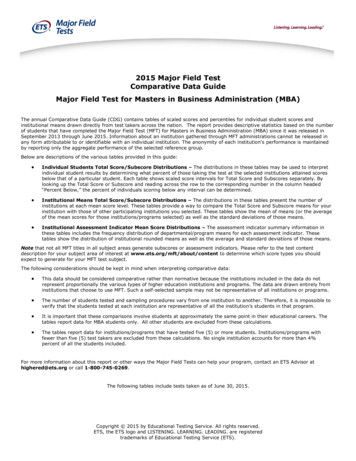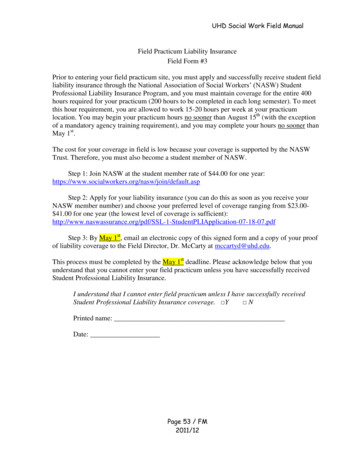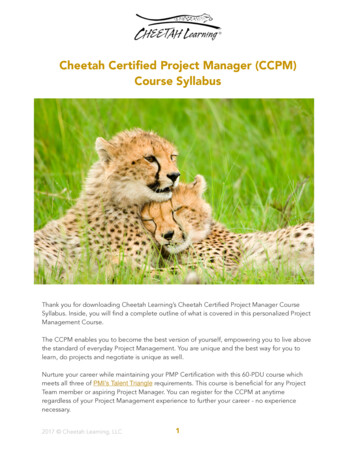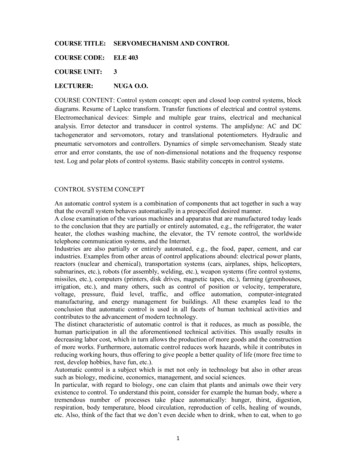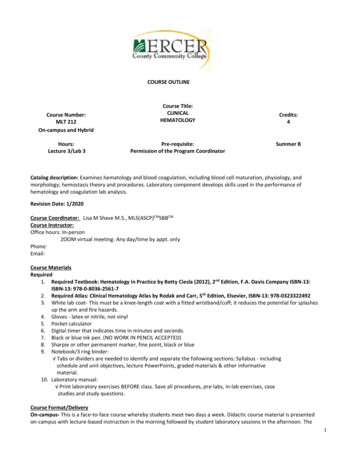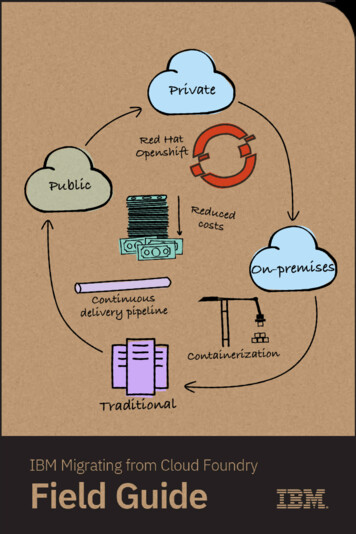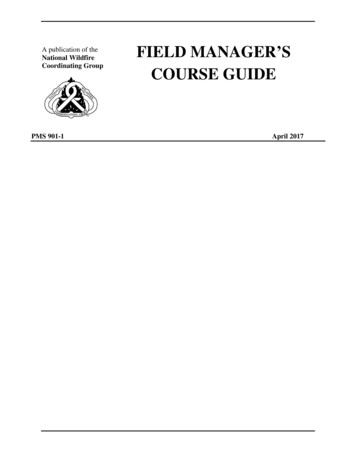
Transcription
A publication of theNational WildfireCoordinating GroupPMS 901-1FIELD MANAGER’SCOURSE GUIDEApril 2017
Field Manager’s Course GuideApril 2017PMS 901-1Sponsored for NWCG publication by the NWCG Operations and Training Committee. Prepared andmaintained by NWCG Training Development Program. Questions regarding the content of this productshould be directed to BLM FA NWCG Training@blm.gov. This product is available electronically athttps://www.nwcg.gov/publications/901-1.Previous editions: April 2014, October 2014, May 2015, September 2015, March 2016, October 2016.The National Wildfire Coordinating Group (NWCG) has approved the contents of this product for theguidance of its member agencies and is not responsible for the interpretation or use of this informationby anyone else.NWCG’s intent is to specifically identify all copyrighted content used in NWCG products. All otherNWCG information is in the public domain. Use of public domain information, including copying, ispermitted. Use of NWCG information within another document is permitted, if NWCG information isaccurately credited to the NWCG. The NWCG logo may not be used except on NWCG authorizedinformation. “National Wildfire Coordinating Group,” “NWCG,” and the NWCG logo are trademarks ofthe National Wildfire Coordinating Group.The use of trade, firm, or corporation names or trademarks in this product is for the information andconvenience of the reader and does not constitute an endorsement by the National Wildfire CoordinatingGroup or its member agencies of any product or service to the exclusion of others that may be suitable.
TABLE OF CONTENTSIntroduction .5Submitting Comments/Recommendations.5NWCG Training Program Position on Course Presentation and Materials .6Course Length for NWCG Courses .7Course Prerequisites.7Establishing a Course as a Prerequisite for another Course . 7Establishing Required Training for Technical Specialist Positions. 8NWCG Course Equivalency Guidelines .8NWCG Interchangeable Course Guidelines .9FEMA National Incident Management System (NIMS) Training .9NWCG Instructor Certification.10Decertification of Instructors: . 11Recertification of Instructors: . 11Exceptions for Lead Instructor Qualifications: . 11Instructor Criteria for 300-600 Level NWCG Courses. 12Instructor Definitions .13Course Level Descriptions .14Testing Standards .15Use of NWCG Certificates .15Course Components Chart Definitions .15Job Aids .16J-158 Radio Operator (2002) . 16J-236 Staging Area Manager (2013) . 16J-252 Ordering Manager (2003) . 16J-253 Receiving and Distribution Manager (2003) . 16J-254 Base/Camp Manager (2004) . 17J-255 Equipment Manager (2004) . 17J-257 Incident Communications Center Manager (2003). 17J-259 Security Manager (2004) . 17J-342 Documentation Unit Leader (2008) . 17Courses .18D-110, Expanded Dispatch Recorder .18D-310, Expanded Dispatch Support Dispatcher .19D-311, Initial Attack Dispatcher .20D-312, Aircraft Dispatcher .21D-510, Expanded Dispatch Supervisory Dispatcher .22FI-110, Wildland Fire Observations and Origin Scene Protection for First Responders .24FI-210, Wildland Fire Origin and Cause Determination .25FI-310, Wildland Fire Investigation: Case Development .26G-131, Wildland Training (FFT1) For Structural Firefighters .28NWCG Field Manager’s Course Guide1
G-231, Wildland Training (ENGB) For Structural Firefighters .30G-330, Wildland Training (STEN) For Structural Firefighters .33ICS-100, Introduction To ICS .35ICS-200, Basic ICS: ICS For Single Resources And Initial Action Incidents .36ICS-300, Intermediate ICS: ICS For Supervisors And Expanding Incidents .37ICS-400, Advanced ICS: ICS For Supervisors And Expanding Incidents .38L-180, Human Factors in the Wildland Fire Service .39L-180, Human Factors in the Wildland Fire Service (Online) .40L-280, Followership to Leadership .41L-380, Fireline Leadership .42L-381, Incident Leadership .44L-480, Organizational Leadership in the Wildland Fire Service .46L-481, Advanced Leadership for Command and General Staff .48L-580, Leadership Is Action .50M-410, Facilitative Instructor .51M-580, Fire in Ecosystem Management .52M-581, Fire Program Management .54P-101, Fire Prevention Education 1 .55P-301, Fire Prevention Education 2 .56P-310, Fire Prevention Education Team Member .57P-410, Fire Prevention Education Team Leader .58RT-130, Annual Fireline Safety Refresher Training .59RT-273, Single Engine Air Tanker Manager Workshop .61RT-340, HRSP Refresher Workshop .63RT-372, Helicopter Manager Workshop .64RT-378, Air Tactical Group Supervisor Refresher .66RX-301, Prescribed Fire Implementation .68RX-310, Introduction to Fire Effects .69RX-341, Prescribed Fire Plan Preparation .71RX-410, Smoke Management Techniques .71RX-510, Advanced Fire Effects.74S-110, Basic Wildland Fire Orientation .76S-130, Firefighter Training .77S-130, Firefighter Training (Blended) .78S-131, Firefighter Type 1.80S-190, Introduction to Wildland Fire Behavior .81S-190, Introduction to Wildland Fire Behavior (Online) .82S-200, Initial Attack Incident Commander .83S-203, Introduction to Incident Information .84S-211, Portable Pumps and Water Use .85NWCG Field Manager’s Course Guide2
S-212, Wildand Fire Chain Saws .86S-215, Fire Operations in the Wildland/Urban Interface .87S-219, Firing Operations.88S-230, Crew Boss (Single Resource) .90S-230, Crew Boss (Single Resource) (Blended) .91S-231, Engine Boss (Single Resource) .93S-231, Engine Boss (Single Resource) (Blended) .95S-236, Heavy Equipment Boss (Single Resource) .96S-244, Field Observer .97S-245, Display Processor .98S-248, Status/Check-In Recorder .99S-258, Incident Communications Technician .100S-260, Interagency Incident Business Management (Online) .101S-261, Applied Interagency Incident Business Management .103S-262, Incident Contract Project Inspector .104S-270, Basic Air Operations .105S-271, Helicopter Crewmember .106S-273, Single Engine Air Tanker Manager .107S-290, Intermediate Wildland Fire Behavior .108S-290, Intermediate Wildland Fire Behavior (Online) .109S-300, Extended Attack Incident Commander .110S-330, Task Force/Strike Team Leader .111S-339, Division/Group Supervisor .112S-340, Human Resource Specialist .113S-341, GIS Specialist for Incident Management .114S-354, Facilities Unit Leader .116S-355, Ground Support Unit Leader .117S-357, Food Unit Leader .118S-358, Communications Unit Leader .119S-359, Medical Unit Leader.120S-371, Helibase Manager .121S-372, Helicopter Management .122S-375, Air Support Group Supervisor .123S-378, Aerial Supervision .124S-390, Introduction to Wildland Fire Behavior Calculations .125S-404, Safety Officer .126S-420, Command and General Staff .127S-430, Operations Section Chief .128S-440, Planning Section Chief .129S-443, Infrared Interpreter for Incident Management .130NWCG Field Manager’s Course Guide3
S-445, Incident Training Specialist .131S-470, Air Operations Branch Director .132S-481, Incident Business Advisor .133S-482, Strategic Operational Planning.134S-490, Advanced Fire Behavior Calculations.136S-491, Intermediate National Fire Danger Rating System .137S-495, Geospatial Fire Analysis, Interpretation, and Application .139S-520, Advanced Incident Management .141S-590, Advanced Fire Behavior Interpretation .143S-620, Area Command .146X-900, Investigating Power Line Caused Wildfires .147NWCG Field Manager’s Course Guide4
INTRODUCTIONThe Field Manager’s Course Guide (FMCG) is designed to provide administrative informationconcerning the National Wildfire Coordinating Group (NWCG) training curriculum. This documentsupersedes any other versions of the Guide. It is to be used in conjunction with the “Wildland FireQualification System Guide,” PMS 310-1. Because this Guide is updated bi-annually it may contradictinformation set forth within course instructor guides; this Guide supersedes all
The National Wildfire Coordinating Group (NWCG) has approved the contents of this product for the guidance of its member agencies and is not responsible for the interpretation or use of this information by anyone else. NWCG’s intent is to specifically identif
